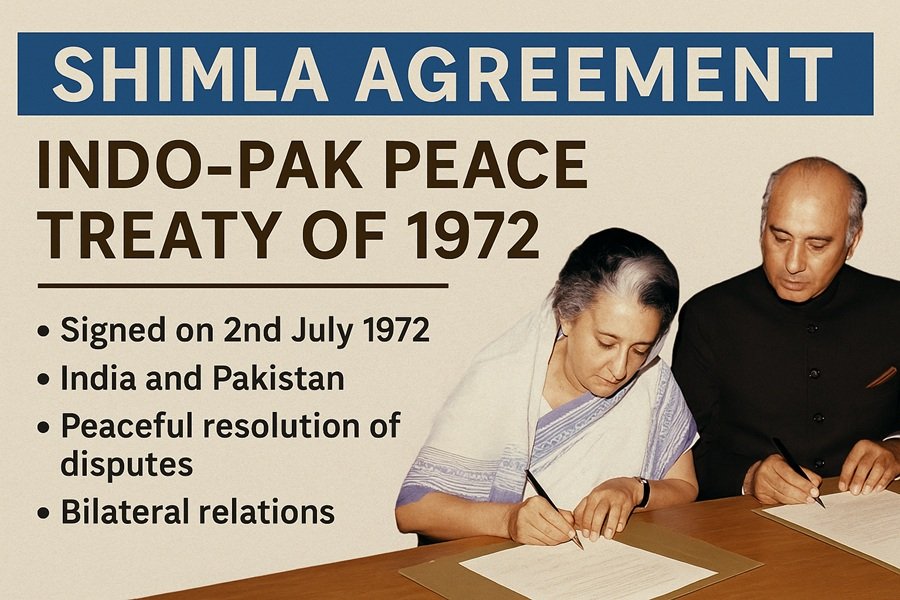
What is the Shimla Agreement? – A Detailed Overview of the Indo-Pak Peace Treaty of 1972
📌 Introduction
The Shimla Agreement, signed on 2nd July 1972, is a landmark treaty between India and Pakistan, aimed at resolving conflicts and establishing lasting peace in the aftermath of the 1971 Indo-Pak war — a war that led to the creation of Bangladesh. This bilateral agreement is considered a foundational framework for peace and diplomatic engagement between the two South Asian neighbors.
Background: Why was the Shimla Agreement Signed?
The Shimla Agreement was signed in the wake of the Indo-Pakistani War of 1971, which was a decisive military and political victory for India. The war was triggered by the Bangladesh Liberation movement in East Pakistan (now Bangladesh), which Pakistan tried to suppress. India’s military intervention supported the Mukti Bahini (freedom fighters), leading to the defeat of Pakistani forces and the surrender of over 93,000 Pakistani soldiers — one of the largest surrenders since World War II.
In order to resolve post-war issues — especially the return of prisoners of war (PoWs), border disputes, and to lay the groundwork for future peace — the Shimla Agreement was signed between:
- Indira Gandhi, Prime Minister of India
- Zulfikar Ali Bhutto, President of Pakistan
The meeting took place in Shimla, the capital of Himachal Pradesh, India.
Key Provisions of the Shimla Agreement
The Shimla Agreement is a short but powerful document that lays out six key principles for India and Pakistan:
1. Peaceful Resolution of Disputes
Both countries agreed to resolve all issues bilaterally through peaceful means, without resorting to armed conflict.
2. Respect for the Line of Control (LoC)
The ceasefire line from December 17, 1971, was to be respected by both parties and converted into the Line of Control (LoC). Neither side would alter it unilaterally.
3. Mutual Respect and Sovereignty
Both India and Pakistan agreed to respect each other’s territorial integrity, political independence, and sovereignty.
4. Non-interference in Internal Affairs
They pledged not to interfere in each other’s internal matters.
5. Promotion of Friendly Relations
The nations committed to fostering friendly relations, increasing people-to-people contact, trade, and cultural exchange.
6. Final Settlement of the Jammu and Kashmir Issue
While the agreement did not specifically resolve the Kashmir dispute, it stated that the Kashmir issue would be resolved bilaterally.
Strategic Implications
✅ Return of PoWs and Territory
India agreed to release all 93,000 Pakistani prisoners of war and returned 13,000 square kilometers of Pakistani territory that was captured during the war.
✅ Bilateralism over Internationalization
The agreement emphasized bilateral dialogue as the only method to resolve disputes — which meant no third-party mediation, including from the UN.
🧠 Critical Analysis
✔️ Successes:
- Avoided another conflict post-1971.
- Normalized diplomatic relations, leading to the return of ambassadors.
- Helped Pakistan regain its lost territory and soldiers peacefully.
❌ Criticisms:
- Vague language on the Kashmir issue left room for different interpretations.
- Critics argue that India lost its upper hand by not securing a final settlement on Kashmir while releasing PoWs and land.
- Pakistan has repeatedly violated the LoC agreement, especially during the Kargil War of 1999.
📘 Aftermath and Relevance Today
Despite its historical importance, the Shimla Agreement has been frequently violated, especially by Pakistan:
- Kargil War (1999): A direct violation of LoC terms.
- Terror attacks and cross-border firing have undermined the “peaceful resolution” clause.
- Pakistan has raised the Kashmir issue at international forums, against the spirit of the agreement.
- India continues to uphold the agreement in its foreign policy, maintaining that all disputes must be resolved bilaterally.
📜 Legal Status of the Shimla Agreement
- It is a bilateral treaty, binding under international law.
- India insists that UN Resolutions on Kashmir are no longer valid after Shimla, since both countries agreed to resolve all issues bilaterally.
- Pakistan, however, often attempts to internationalize Kashmir, contradicting the agreement’s terms.
🤝 Legacy of the Shimla Agreement
The Shimla Agreement is more than a peace treaty — it represents:
- India’s diplomatic generosity despite military victory
- An attempt to reshape Indo-Pak relations on the principles of coexistence and dialogue
- A political landmark that still influences South Asian geopolitics
🧭 Conclusion
The Shimla Agreement of 1972 remains one of the cornerstones of Indo-Pak relations. While its objectives were noble — peace, dialogue, and cooperation — the lack of trust and repeated violations have eroded its efficacy over time. Nonetheless, the agreement still serves as a diplomatic reference point for peaceful engagement between the two nuclear-armed neighbors.
For India, it is a testament to a responsible foreign policy. For Pakistan, it is both a diplomatic opportunity and a historical lesson. And for South Asia, it remains a reminder that peace is achievable only through commitment, consistency, and cooperation.






